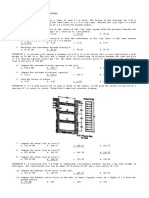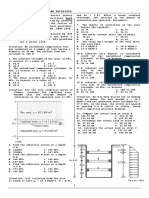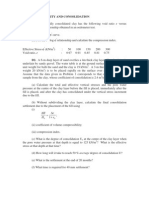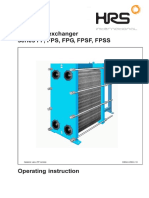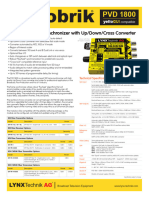Evaluation Exam 8
Uploaded by
Michael MercadoEvaluation Exam 8
Uploaded by
Michael MercadoKIPPAP EDUCATION
Evaluation Exam 8
INSTRUCTION: Select the correct answer for each of the following questions. Mark only one answer
for each item by shading the box corresponding to the letter of your choice on the answer sheet
provided. STRICTLY NO ERASURES ALLOWED.
Situation I: A smooth, vertical wall retains a 7 m high granular backfill with the ground level being
horizontal. The water table lies at a depth of 3 m from the top. The friction angle of the
backfill is 32degrees. The moist unit weight and saturated unit weight of the soil are 16.5
kN/m^3 and 18 kN/m^3 respectively. Assuming the soil is in active state.
1. What is the coefficient of lateral earth pressure?
a. 0.26 c. 0.49
b. 0.31 d. 0.14
2. What is the magnitude of the total active force on the wall?
a. 182.18 kN c. 155.17 kN
b. 226.36 kN d. 200.26 kN
3. What is the location from the bottom of the horizontal thrust on the wall?
a. 2.02m c. 1.84m
b. 3.67m d. 2.43m
Situation II: According to Section 304 of the National Structural Code of the Philippines, the
presumptive load bearing capacity of gravelly, in the absence of exhaustive geotechnical
site assessment and investigation, is 100 kPa for a minimum footing width of 300mm and
a minimum depth of embedment of 300mm. This value can be increase by 20% for each
additional 300mm of width of footing and/or depth of founding to a maximum of three (3)
times the designated value.
4. Evaluate the allowable bearing capacity, in kPa, of the soil for a square footing 1.2m
wide founded at a depth of 300mm below ground surface.
a. 200 kPa c. 150 kPa
b. 175 kPa d. 160 kPa
5. Evaluate the allowable bearing capacity of the soil for a footing 1.2m wide when
founded at a depth of 900mm below ground surface.
a. 178 kPa c. 298 kPa
b. 323 kPa d. 224 kPa
6. Determine the safe downward load, in kN, that the footing of the preceding question can
support.
a. 178 kPa c. 298 kPa
b. 323 kPa d. 224 kPa
7. Section 302.2.2 of the National Structural Code of the Philippines provides that the
slope of cut surfaces of the ground shall be no steeper than is safe for the intended use
and shall be no steeper that:
a. 1:2 c. 1:1.5
b. 1:3 d. 1:1
Kippap Education
0905 664 2628 kippapeducation@gmail.com CE Board Exam Review
KIPPAP EDUCATION
Evaluation Exam 8
SITUATION III: A soil has the following properties:
𝑘𝑁
Unit weight, 𝛾 = 19.2 𝑚3 𝑁′𝑐 = 8
Cohesion, c= 50 kPa 𝑁 ′ 𝑞 = 1.94
Angle of friction, ∅ = 10° 𝑁 ′ 𝛾 = 0.25
8. Calculate the net bearing capacity for a strip footing of width 1.25m at a depth of 4.5m.
a. 437.3 kPa c. 496.3 kPa
b. 350.8 kPa d. 472.5 kPa
9. Considering shear failure only, calculate the safe bearing pressure on a footing 6m long
by 1.25m wide, using a load factor of 2.5. Given by the formula:
𝑞𝑢𝑛𝑒𝑡
𝑞𝑠 = + 𝛾𝐷𝑓
𝐹𝑆
a. 185.7 kPa c. 233.5 kPa
b. 287.6 kPa d. 224.1 kPa
10. What is the safe total load of the footing?
a. 1751 kN c. 1854 kN
b. 2125 kN d. 1524 kN
SITUATION III: A sandy soil has a drained angle of friction of 32°. The deviator stress at failure is
400kPa.
11. Compute the angle that the failure plane makes with the major principal plane.
a. 61° c. 59°
b. 60° d. 63°
12. Determine the chamber confining pressure in kPa.
a. 175.24 kPa c. 177.42 kPa
b. 181.28 kPa d. 163.54 kPa
13. Compute the shear stress in kPa at the point on the failure plane.
a. 125.14 c. 358.41
b. 169.61 d. 205.54
SITUATION IV: A braced cut in sand 7m deep is shown. In the plan, the struts area placed at s=2.0m
center to center. Use peck’s empirical pressure diagram.
14. What is the reaction on strut A.
a. 116.03 kN c. 126.55 kN
b. 101 kN d. 89.20 kN
15. What is the reaction on strut B.
a. 66.95 kN c. 49.20 kN
b. 56.30 kN d. 38.68 kN
Kippap Education
0905 664 2628 kippapeducation@gmail.com CE Board Exam Review
KIPPAP EDUCATION
Evaluation Exam 8
16. What is the reaction on strut C.
a. 180.90 c. 69.20
b. 206.27 d. 126.85
5m
1m
SAND
A ∅ = 30°
2m 𝑘𝑁
𝛾 = 17
𝑚3
B
2m
C
2m
17. _______ is the component of shear strength of a rock or soil that is independent of
interparticle friction.
a. Cohesion c. Soil friction angle
b. Adhesion d. Soil friction repose
18. A _________ is a common method to measure the mechanical properties of many
deformable solids, especially soil and rock, and other granular materials, it is one of the most
reliable methods available for determining the shear strength parameters.
a. Direct Shear Test c. Consolidated-drained Test
b. Triaxial Shear Test d. Consolidated-undrained Test
19. It is the oldest and and simplest form of shear test arrangement. The test equipment
consist of a metal shear box in which the soil specimen is placed.
a. Direct Shear Test c. Consolidated-drained Test
b. Triaxial Shear Test d. Direct Shear Test
20. ________ is a shear strength parameter of soils. Definition is derived from the Mohr-
Coulomb failure criterion and it used to describe friction shear resistance of soils together with
the normal effective stress.
a. Cohesion c. Soil friction repose
b. Adhesion d. Soil friction angle
SITUATION V: According to the Bousinessq theory, the vertical stress at point below the surface
a semi-infinite, homogenous, isotropic soil mass due to a point load Q applied at
the ground surface is given by the equation:
P = 0.477 QN/z^2 where N= 1/[1+ 9(r/z)^2]^2.5
r = horizontal distance from the point of the load
z = depth of point below ground surface.
Evaluate the vertical stress, in kPa, at a point below the ground for Q=1500kN.
Kippap Education
0905 664 2628 kippapeducation@gmail.com CE Board Exam Review
KIPPAP EDUCATION
Evaluation Exam 8
21. If the point is 2.5 m directly below the point of application of the load.
a. 110 c. 77.9
b. 114 d. 99.5
22. If the point is 5 m directly below the point of application of the load.
a. 18.5 c. 25.5
b. 19.6 d. 28.6
23. If the point is 2.5 m below the load but 3 m horizontally from its line of application.
a. 16.1 c. 12.3
b. 14.9 d. 18.2
SITUATION VI: Water flows through a 100 mm diameter granular soil specimen as shown. The
water levels on both sides are maintained constant during the test, and the void
ratio of the soil is 0.82, and G = 2.68.
200 mm
650 mm
24. Calculate the critical hydraulic gradient.
a. 1.12 c. 1.03
b. 0.839 d. 0.923
25. What is the maximum possible h such that the soil does not reach quick condition?
a. 545 mm c. 700 mm
b. 600 mm d. 728 mm
SITUATION VII. During an unconsolidated-undrained tri-axial test on a clayey soil specimen, the
minor and major principal stresses at failure were 100 kPa and 180 kPa,
respectively.
Kippap Education
0905 664 2628 kippapeducation@gmail.com CE Board Exam Review
KIPPAP EDUCATION
Evaluation Exam 8
26. Find the angle of friction for the unconsolidated tri-axial test
a. 16.6° c. 23°
b. 16.0° d. 0°
27. Find the cohesion for the similar specimen if subjected to an unconfined compression
test.
a. 80 c. 50
b. 40 d. 100
28. What will be the axial stress at failure if a similar specimen is subjected to an unconfined
compression test?
c. 80 c. 50
d. 40 d. 100
SITUATION VIII. A prestressed concrete pile, 350 mm x 350 mm in cross-section, is driven in a clayey
soil with unit weight of 18.5 kN/m3. Use a factor of safety of 2.5. The unconfined
compression strength of the soil is 110 kPa. FS=2.5 Nc=9 and β=0.75. Consider that
the design capacity of 380kN.
29. Compute the value of the side shear capacity of the pile in kN.
a. 889.36 c. 879.53
b. 866.25 d. 686.52
30. Compute the value of the end bearing capacity of the pile in kN.
a. 60.64 c. 67.38
b. 78.84 d. 65.32
31. Determine the length of pile.
a. 6.67 m c. 10.23 m
b. 9.57 m d. 8.96 m
SITUATION IX: The weir shown has a base of which 2 m. below the ground surface. The pressure
distribution diagram at the base of the weir can be obtained from the equipotential
lines as follows: Coefficient of permeability, K=4m/day
Kippap Education
0905 664 2628 kippapeducation@gmail.com CE Board Exam Review
KIPPAP EDUCATION
Evaluation Exam 8
32. Compute the uplift pressure at d
a. 78.48 kPa c. 29.43 kPa
b. 68.67 kPa d. 49.05 kPa
33. Compute the uplift force per unit length
a. 809.33 kN/m c. 384.44 kN/m
b. 607.35 kN/m d. 715.24 kN/m
34. Seepage through the foundation
a. 87.12 m^3/day c. 65.33 m^3/day
b. 45.67 m^3/day d. 51.54 m^3/day
35. A retaining wall having a height of 1.5 m. is supporting two layers of cohesive soil having
the characteristics as shown in the figure. Compute the active force after the occurrence
of the tensile crack.
a. 3.6kN/m c. 4.1kN/m
b. 2.7kN/m d. 3kN/m
Situation X: A soil element is shown in the figure below.
36. Compute the magnitude of the principal stresses.
a. 111.51 kPa c. 88.49 kPa
b. 253.23 kPa d. 164.33 kPa
37. Compute the normal stress on plane AB.
a. 111.51 kPa c. 88.49 kPa
b. 253.23 kPa d. 164.33 kPa
Kippap Education
0905 664 2628 kippapeducation@gmail.com CE Board Exam Review
KIPPAP EDUCATION
Evaluation Exam 8
38. Shear stress on plane AB.
a. 111.51 kPa c. 88.49 kPa
b. 253.23 kPa d. 164.33 kPa
Situation XI: A cut slope is to be made. The unit weight of the soil is 15.74 kN/m^3 and an angle of
friction is 10°. The soil has a cohesion of 28.8 kPa. The trial failure plane makes an
angle of 30° with the horizontal while the cut slope makes an angle of 50° with the
horizontal. If the height of the slope is 3m, determine the following:
39. Determine the force due to cohesion (kN).
a. 9.66 c. 54.79
b. 172.8 d. 31.635
40. Determine the total force that resists sliding (kN).
a. 31.635 c. 182.46
b. 204.44 d. 41
41. The factor of safety against sliding.
a. 5.77 c. 6.25
b. 4.98 d. 5.15
42. Critical height if the factor of safety is 3
a. 8.65 c. 17.86
b. 6.10 d. 11.13
Situation XII: The pile group shown below consists of 12 piles, each 0.4m in diameter, arranged in 3x4
matrix. The pile penetrates a soft clay (𝐿1 = 2𝑚, 𝐶𝑢1 = 20 𝑘𝑃𝑎), a medium dense clay
(𝐿2 = 6𝑚, 𝐶𝑢1 = 60 𝑘𝑃𝑎), and a stiff clay (𝐿3 = 4𝑚, 𝐶𝑢1 = 95 𝑘𝑃𝑎). Assume 𝑁𝑐 = 9 and
use 𝛼 = 1 for soft and medium dense clay, and 𝛼 = 0.5 for stiff clay determine the
following:
1.2𝑚 1.2𝑚 1.2𝑚
𝐿1 = 2𝑚, 𝐶𝑢1
= 20 𝑘𝑃𝑎
1.2𝑚
𝐿2 = 6𝑚, 𝐶𝑢1
1.2𝑚 = 60 𝑘𝑃𝑎
𝐿3 = 4𝑚, 𝐶𝑢1
= 95 𝑘𝑃𝑎
Kippap Education
0905 664 2628 kippapeducation@gmail.com CE Board Exam Review
KIPPAP EDUCATION
Evaluation Exam 8
43. Determine the capacity of the pile group based on single pile failure mode.
a. 10,189.2 kN c. 9,325.7 kN
b. 15,452.3 kN d. 17,600 kN
44. Determine the capacity of the pile group based on block failure mode.
a. 17,600 kN c. 10,189.2 kN
b. 10,189.2 kN d. 10,189.2 kN
45. Compute the maximum center to center spacing of the piles for 100% efficiency.
a. 783mm c. 633mm
b. 514mm d. 495mm
Kippap Education
0905 664 2628 kippapeducation@gmail.com CE Board Exam Review
You might also like
- ZIMSEC O Level Combined Science Past Exam Paper 2 Set 2100% (8)ZIMSEC O Level Combined Science Past Exam Paper 2 Set 25 pages
- Assessment Exam 04: Geotechnical EngineeringNo ratings yetAssessment Exam 04: Geotechnical Engineering7 pages
- Virtual EAV: The Electro-Dermal Screening Test100% (1)Virtual EAV: The Electro-Dermal Screening Test21 pages
- RM 46 - Geotechnical Engineering 6 (Slope-Capacity)No ratings yetRM 46 - Geotechnical Engineering 6 (Slope-Capacity)4 pages
- Effective Stress (Without Seepage) : (18.345 Kn/M3) (183.924 Kpa) (105.444 Kpa)100% (1)Effective Stress (Without Seepage) : (18.345 Kn/M3) (183.924 Kpa) (105.444 Kpa)19 pages
- Assessment Exam 04: Geotechnical EngineeringNo ratings yetAssessment Exam 04: Geotechnical Engineering7 pages
- Geo-Stresses-in-Soil-Shear-Strength-Terzaghi (1)No ratings yetGeo-Stresses-in-Soil-Shear-Strength-Terzaghi (1)3 pages
- Stresses in Soil Mass Problem 1: Foundation Engineering 1No ratings yetStresses in Soil Mass Problem 1: Foundation Engineering 13 pages
- Refresher Module 03 Geotechnical Engineering and HydraulicsNo ratings yetRefresher Module 03 Geotechnical Engineering and Hydraulics2 pages
- Prepared By: Engr. Rolando A. Bitagun JR., ME-CE USL 2019-2020No ratings yetPrepared By: Engr. Rolando A. Bitagun JR., ME-CE USL 2019-20204 pages
- Pressure, Resistance, and Stability of Earth American Society of Civil Engineers: Transactions, Paper No. 1174, Volume LXX, December 1910From EverandPressure, Resistance, and Stability of Earth American Society of Civil Engineers: Transactions, Paper No. 1174, Volume LXX, December 1910No ratings yet
- Encyclopaedia Britannica, 11th Edition, Volume 8, Slice 3 "Destructors" to "Diameter"From EverandEncyclopaedia Britannica, 11th Edition, Volume 8, Slice 3 "Destructors" to "Diameter"No ratings yet
- Real Estate License Exam Calculation Workbook: Volume 2 (2024 Edition)From EverandReal Estate License Exam Calculation Workbook: Volume 2 (2024 Edition)No ratings yet
- Mathematics Paper 2 Marking Scheme 1 (1)No ratings yetMathematics Paper 2 Marking Scheme 1 (1)8 pages
- Chapter 9 Mechanical Properties of SolidsNo ratings yetChapter 9 Mechanical Properties of Solids16 pages
- Video Essay Script For Hairspray Character Analysis ThingyNo ratings yetVideo Essay Script For Hairspray Character Analysis Thingy23 pages
- Biology : the essentials 3rd Edition Mariëlle Hoefnagels - The ebook is available for instant download, read anywhere100% (1)Biology : the essentials 3rd Edition Mariëlle Hoefnagels - The ebook is available for instant download, read anywhere52 pages
- Polyvinylsiloxanes in Dentistry: An Overview: Trends in Biomaterials and Artificial Organs July 2013No ratings yetPolyvinylsiloxanes in Dentistry: An Overview: Trends in Biomaterials and Artificial Organs July 201310 pages
- Problems Encountered in Diaphragm Wall Excavation100% (1)Problems Encountered in Diaphragm Wall Excavation5 pages
- Lynx Yellobrik PVD1800 HDSDI Frame Sync - Rev08No ratings yetLynx Yellobrik PVD1800 HDSDI Frame Sync - Rev083 pages
- Blueprint for Revolution How to Use Rice Pudding Lego Men and Other Nonviolent Techniques to Galvanize Communities Overthrow Dictators or Simply Change the World Srdja Popovic - The 2025 ebook edition is available with updated content100% (1)Blueprint for Revolution How to Use Rice Pudding Lego Men and Other Nonviolent Techniques to Galvanize Communities Overthrow Dictators or Simply Change the World Srdja Popovic - The 2025 ebook edition is available with updated content61 pages



































